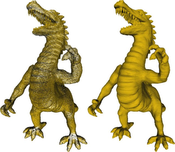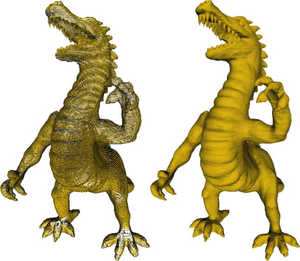Information
- Publication Type: PhD-Thesis
- Workgroup(s)/Project(s):
- Date: July 2012
- Date (Start): September 2006
- Date (End): July 2012
- TU Wien Library:
- 1st Reviewer: Dr. F. Samavati
- 2nd Reviewer:
- Dr. T. Bui
- Dr. P. Grogono
- Dr. A. Agarwal
- Rigorosum: 12. July 2012
- First Supervisor: Sudhir Mudur
- Keywords: Surface Reconstruction, Manifold Reconstruction, Point Cloud, Shape Boundary, Gestalt, Curve Reconstruction
Abstract
Given a point cloud, in the form of unorganized points, the problem of automatically connecting the dots to obtain an aesthetically pleasing and piecewise-linear closed interpolating boundary shape has been extensively researched for over three decades. In R3 , it is even more complicated to find an aesthetic closed oriented surface. Most previous methods for shape reconstruction exclusively from coordinates work well only when the point spacing on the shape boundary is dense and locally uniform. The problem of shape construction from non-dense and locally non-uniformly spaced point sets is in our opinion not yet satisfactorily solved. Various extensions to earlier methods do not work that well and do not provide any performance guarantees either.
Our main thesis in this research is that a point set, even with non-dense and locally non-uniform spacing, has an intrinsic shape which optimizes in some way the Gestalt principles of form perception. This shape can be formally defined as the minimum of an energy function over all possible closed linear piece-wise interpolations of this point set. Further, while finding this optimal shape is NP-hard, it is possible to heuristically search for an acceptable approximation within reasonable time.
Our minimization objective is guided by Gestalt’s laws of Proximity, Good Continuity and Closure. Minimizing curvature tends to satisfy proximity and good continuity. For computational simplification, we globally minimize the longest-edge-in-simplex, since it is intrinsic to a single facet and also a factor in mean curvature. And we require a closed shape.
Using such an intrinsic criterion permits the extraction of an approximate shape with a linearithmic algorithm as a simplicial complex, which we have named the Minimum Boundary Complex. Experiments show that it seems to be a very close approximation to the desired boundary shape and that it retains its genus. Further it can be constructed locally and can also handle sensor data with significant noise. Its quick construction is due to not being restricted by the manifold property, required in the boundary shape. Therefore it has many applications where a manifold shape is not necessary, e.g. visualization, shape retrieval, shadow mapping, and topological data analysis in higher dimensions. The definition of the Minimum Boundary Complex is our first major contribution.
Our next two contributions include new methods for constructing boundary shapes by transforming the boundary complex into a close approximation of the minimum boundary shape. These algorithms vary a topological constraint to first inflate the boundary complex to recover a manifold hull and then sculpture it to extract a Minimum Boundary approximation, which interpolates all the points. In the R3 method, we show how local minima can be avoided by covering holes in the hull. Finally, we apply a mesh fairing step to optimize mean curvature directly. We present results for shape construction in R2 and R3 , which clearly demonstrate that our methods work better than the best performing earlier methods for non-dense and locally non-uniformly spaced point sets, while maintaining competitive linearithmic complexity.
Additional Files and Images
Additional images and videos
Additional files
Weblinks
No further information available.
BibTeX
@phdthesis{ohrhallinger-stefan-2012-the,
title = "The Intrinsic Shape of Point Clouds",
author = "Stefan Ohrhallinger",
year = "2012",
abstract = "Given a point cloud, in the form of unorganized points, the
problem of automatically connecting the dots to obtain an
aesthetically pleasing and piecewise-linear closed
interpolating boundary shape has been extensively researched
for over three decades. In R3 , it is even more complicated
to find an aesthetic closed oriented surface. Most previous
methods for shape reconstruction exclusively from
coordinates work well only when the point spacing on the
shape boundary is dense and locally uniform. The problem of
shape construction from non-dense and locally non-uniformly
spaced point sets is in our opinion not yet satisfactorily
solved. Various extensions to earlier methods do not work
that well and do not provide any performance guarantees
either. Our main thesis in this research is that a point
set, even with non-dense and locally non-uniform spacing,
has an intrinsic shape which optimizes in some way the
Gestalt principles of form perception. This shape can be
formally defined as the minimum of an energy function over
all possible closed linear piece-wise interpolations of this
point set. Further, while finding this optimal shape is
NP-hard, it is possible to heuristically search for an
acceptable approximation within reasonable time. Our
minimization objective is guided by Gestalt’s laws of
Proximity, Good Continuity and Closure. Minimizing curvature
tends to satisfy proximity and good continuity. For
computational simplification, we globally minimize the
longest-edge-in-simplex, since it is intrinsic to a single
facet and also a factor in mean curvature. And we require a
closed shape. Using such an intrinsic criterion permits the
extraction of an approximate shape with a linearithmic
algorithm as a simplicial complex, which we have named the
Minimum Boundary Complex. Experiments show that it seems to
be a very close approximation to the desired boundary shape
and that it retains its genus. Further it can be constructed
locally and can also handle sensor data with significant
noise. Its quick construction is due to not being restricted
by the manifold property, required in the boundary shape.
Therefore it has many applications where a manifold shape is
not necessary, e.g. visualization, shape retrieval, shadow
mapping, and topological data analysis in higher dimensions.
The definition of the Minimum Boundary Complex is our first
major contribution. Our next two contributions include new
methods for constructing boundary shapes by transforming the
boundary complex into a close approximation of the minimum
boundary shape. These algorithms vary a topological
constraint to first inflate the boundary complex to recover
a manifold hull and then sculpture it to extract a Minimum
Boundary approximation, which interpolates all the points.
In the R3 method, we show how local minima can be avoided by
covering holes in the hull. Finally, we apply a mesh fairing
step to optimize mean curvature directly. We present results
for shape construction in R2 and R3 , which clearly
demonstrate that our methods work better than the best
performing earlier methods for non-dense and locally
non-uniformly spaced point sets, while maintaining
competitive linearithmic complexity. ",
month = jul,
address = "Favoritenstrasse 9-11/E193-02, A-1040 Vienna, Austria",
school = "Institute of Computer Graphics and Algorithms, Vienna
University of Technology ",
keywords = "Surface Reconstruction, Manifold Reconstruction, Point
Cloud, Shape Boundary, Gestalt, Curve Reconstruction",
URL = "https://www.cg.tuwien.ac.at/research/publications/2012/ohrhallinger-stefan-2012-the/",
}
 thumbnail:
2D and 3D Reconstruction
thumbnail:
2D and 3D Reconstruction
 Phd-Thesis:
Phd-Thesis
Phd-Thesis:
Phd-Thesis


 Phd-Thesis
Phd-Thesis